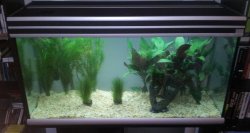UNV_Rasta
Fish Fanatic
Hey AC, man it seems like finding separate leads and stuff is almost impossible in my part. I had no problem locating the ballasts, but the leads, no luck. Checked quite a few electrical spots too, just not common here in Trinidad. Interesting though, I did see a 25 W T12 bulb @ a lfs. Do you think that extra 5 W could make the difference I need? Also, trying to find a ready made double-tube fixture for a tank my size (which is 22g btw not 25 as i stated) is almost impossible

 .
. 
